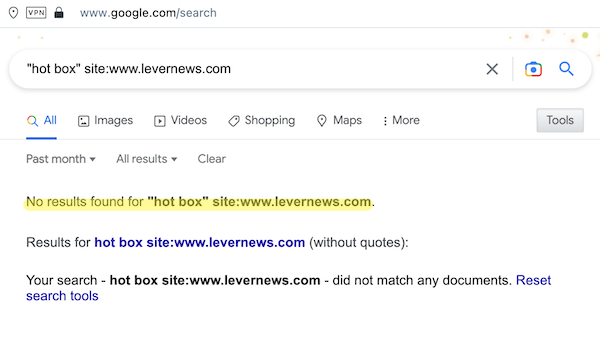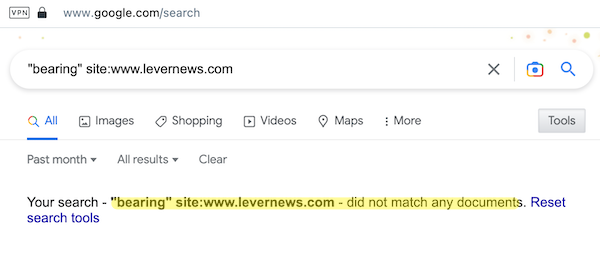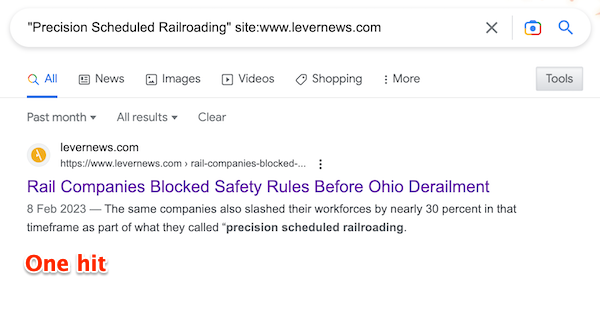By Lambert Strether of Corrente.
On February 3, 2023, 38 cars of Norfolk Southern train 32N derailed in East Palestine, OH. 20 cars were carrying hazardous materials; several burned for more than two days, after which emergency crews conducted a “controlled burn” of the remaining chemicals:
The effects of the derailment and subsequent events on health, the air, the water, and the soil are still being sorted.
On February 23, 2023, the National Transportation Safety Board released its preliminary report on the derailment: “Norfolk Southern Railway Train Derailment with Subsequent Hazardous Material Release and Fires.” From that report:
While on scene, National Transportation Safety Board (NTSB) investigators examined railroad equipment and track conditions; reviewed data from the signal system, wayside defect detectors, local surveillance cameras, and the lead locomotive’s event recorder and forward-facing and inward-facing image recorders; and completed interviews. NTSB investigators identified and examined the first railcar to derail, the 23rd railcar in the consist. Surveillance video from a local residence showed what appeared to be a wheel bearing in the final stage of overheat failure moments before the derailment. The wheel bearing and affected wheelset have been collected as evidence and will be examined by the NTSB….
Train 32N was operating with a dynamic brake application as the train passed a wayside defect detector on the east side of Palestine, Ohio, at milepost (MP) 49.81. The wayside defect detector, or hot bearing detector (HBD), transmitted a critical audible alarm message instructing the crew to slow and stop the train to inspect a hot axle. The train engineer increased the dynamic brake application to further slow and stop the train. During this deceleration, an automatic emergency brake application initiated, and train 32N came to a stop.
On the Fort Wayne Line of the Keystone Division, NS has equipped their rail network with HBD systems to assess the temperature conditions of wheel bearings while en route. The function of the HBD is to detect overheated bearings and provide audible real-time warnings to train crews. Train 32N passed three HBD systems on its trip before the derailment. At MP 79.9, the suspect bearing from the 23rd car had a recorded temperature of 38°F above ambient temperature. When train 32N passed the next HBD, at MP 69.01, the bearing’s recorded temperature was 103°F above ambient. The third HBD, at MP 49.81, recorded the suspect bearing’s temperature at 253°F above ambient. NS has established the following HBD alarm thresholds (above ambient temperature) and criteria for bearings:
• Between 170°F and 200°F, warm bearing (non-critical); stop and inspect
• A difference between bearings on the same axle greater than or equal to 115°F (non-critical); stop and inspect
• Greater than 200°F (critical); set out railcar After the train stopped, the crew observed fire and smoke and notified the Cleveland East dispatcher of a possible derailment.
Or as Railfan and Railroad summarizes: “NTSB: Hot Bearing Caused East Palestine Wreck.”
On February 12, 2022, we wrote, in “How Precision Scheduled Railroading at Norfolk Southern Caused a Toxic Vinyl Chloride Mushroom Cloud Over East Palestine, Ohio“:
If a bearing overheats, it’s called a “hot box.” The heat is intense, and can damage the truck or even the car. The result will be a derailment. And the train that derailed at East Palestine had a hot box.
And we concluded:
No doubt [Norfolk Southern’s owners] are very happy with the Operating Ratio that [Norfolk Southern] achieved through [Precision Scheduled Railroading]. The chain of causality that begins with the hot box ends at their desks.
So NC got the story right and early. How did we do that? Simple. Railroad workers on the ground were our key sources (hat tip to John Russell of The Holler, who interviewed railroader Clyde Whitaker, chair of SMART local 145 and Ohio Legislative Director; quotes from other workers were left on the cutting room floor). Railroad workers on the ground understood the hot box issue, understood how trains are built (“blocking”), and understood the effects of Norfolk Southern’s vicious speedup, Precision Scheduled Railroading, which has slashed headcount by 30%, cutting maintenance generally, and cutting inspections which might have prevented it.
Meanwhile, the good folks at Lever News were all over the story, even (kudos to them) delivering an Op-Ed to the New York Times (of which more later). However, they got the story wrong. Let’s search on “hot box”:

Nothing. To be fair, let’s search on the less idiomatic “bearing”:

And let’s search on “Precision Scheduled Railroading”:

One hit (in the very first story on Feb 8, 2023, as we shall see). Here it is:
The same companies also slashed their workforces by nearly 30 percent in that timeframe as part of what they called “precision scheduled railroading.” Such staffing cuts are likely contributing to safety issues in freight railways. In a recent investor presentation, Norfolk Southern disclosed an increase in train accidents over the past three consecutive years.
“The massive reduction in the workforce, attendance policies that encourage people to come to work when they’re sick or exhausted, lack of access to [paid] leave, the stress that is constantly put on workers because of how lean the workforce has become, it creates a negative culture in terms of safety,” Greg Regan, president of the Transportation Trades Department of the AFL-CIO, told The Lever.
As you can see, Lever News in no way connects Precision Scheduled Railroading (PSR) to the hotbox that derailed train 32N. In fact, doesn’t even mention the hotbox.That’s because Lever News had and has an alternative theory of the case, unsupported by any evidence, and unmentioned in the NTSB’s preliminary report. We can see this best by putting the laudably exhaustive Lever News coverage in the form of a table[1]. I read all the articles. They are numbered in the left-hand column for easy reference.
Table 1: East Palestine Derailment Coverage at Lever News
| Precision Scheduled Railroading | Workers on the Ground | “Hot Box” | Bearing | Inspections | Paywall | Lever News Story | |
| (1) | ☒ | ☐ | ☐ | ☐ | ☐ | ☐ | (Feb 8, 2023) Rail Companies Blocked Safety Rules Before Ohio Derailment (podcast version) |
| (2) | ☐ | ☐ | ☐ | ☐ | ☐ | ☐ | (Feb 10, 2023) There Will Be More Derailments |
| (3) | ☐ | ☐ | ☐ | ☐ | ☐ | ☒ | (Feb 12, 2023) The Man Responsible |
| (4) | ☐ | ☐ | ☐ | ☐ | ☐ | ☒ | (Feb 14, 2023) Q&A About The Norfolk Southern Train Derailmen (podcast) (no transcript available) |
| (5) | ☐ | ☐ | ☐ | ☐ | ☐ | ☐ | (Feb 15, 2023) Buttigieg Pretends He’s Powerless To Reduce Derailment Risks |
| (6) | ☐ | ☐ | ☐ | ☐ | ☐ | ☐ | (Feb 16, 2023 Watch And Share Our Videos On The Derailment Disaster (in particular: “What Caused The Train Derailment In Ohio?”) |
| (7) | ☐ | ☐ | ☐ | ☐ | ☐ | ☐ | (Feb 16, 2023) “Biden DOJ Backing Norfolk Southern’s Bid To Block Lawsuits” |
| (8) | ☐ | ☐ | ☐ | ☐ | ☐ | ☐ | (Feb 17, 2023) Enviros Threaten Legal Action If Buttigieg Doesn’t Act |
| (9) | ☐ | ☐ | ☐ | ☐ | ☐ | ☐ | (Feb 20, 2023) Driving The Narrative |
| (10) | ☐ | ☐ | ☐ | ☐ | ☐ | ☒ | (Feb 22, 2023) How The Lever Forced Buttigieg To Do His Job (transcript) |
| (11) | ☒ | ☒ | ☒ | ☒ | ☒ | ☒ | (Feb 22, 2023) On The Ground In East Palestine (w/ John Russell) (full transcript from John Russell’s The Holler). |
| (12) | ☐ | ☐ | ☐ | ☐ | ☐ | ☐ | (Feb 23, 2023) After Norfolk Southern Support, DeWine Says No Disaster In East Palestine |
| (13) | ☐ | ☐ | ☐ | ☐ | ☐ | ☒ | (Feb 26, 2023) Shadowbanning An Inconvenient Truth |
When an item occurs in an article, it’s ☒ed, like “Precision Scheduled Railroading” in (1). Otherwise, it’s ☐ed.
Summarizing our results, you can easily see that “Precision Scheduled Railroading” is mentioned only twice, and only once in the context of the actual derailment. You can also see that bearings/”hot boxes,” inspections, and Precision Scheduled Railroading are mentioned in only one article, which is also the only article that uses workers on the ground as sources. And you can see that this article is paywalled, part of a podcast, and that the full transcript is not available on the Lever News site. So, to Lever News, workers are not sources, and Precision Scheduled Railroading and its discontents are not part of the story. Which is why they got the story wrong. That’s because they have a different theory of the case. To understand that theory, let’s dig into each of the articles:
From (1), introducing “Brake Theory,” Lever News’ theory of the case:
According to federal investigators, the derailment was caused by a mechanical issue with a rail car axle. [Steven Ditmeyer, a former senior official at the Federal Railroad Administration] and two other experts told The Lever that [Electronically Controlled Pneumatic (ECP)] braking probably would have reduced the damage caused by the derailment by bringing the train to a halt more quickly and stopping all of the cars simultaneously.
“If the axle breaks, it’s almost certain that the train is going to derail,” said John Risch, a former BNSF engineer and national legislative director for the Sheet Metal, Air, Rail, and Transportation Union. “ECP brakes would help to bring the train to a stop. What they do is activate the brakes on each car at the same time immediately. That’s significant: When you apply the brakes on a conventional train, they brake from the front to the rear. The cars bunch up.”
Risch said that ECP brakes are the “most remarkable advancement” he ever encountered in his 31-year career as a railroad worker, adding: “It needs to be implemented.”
Note that The Lever’s sources are wrong on the cause of the derailment (it was a “hot box,” not a broken axle[2]). Note also that ECP would not have prevented the derailment, but only reduced the damage. Finally, note the lack of worker sources on the ground. The Lever did not source anybody familiar with Train 32N, or anybody local.
From (2), Brake Theory continues. The headline: “It’s Time For ECP Brakes.” There’s no mention of East Palestine at all. It would seem that for Lever News, the story has congealed by February 10.
From (5), Brake Theory goes political. “A Twitter thread posted more than a week after Norfolk Southern’s fiery train derailment in East Palestine, Ohio, Buttigieg indicated that he cannot reinstate an Obama-enacted, Trump-repealed law requiring some trains carrying hazardous materials to replace their Civil War-era braking systems with new Electronically Controlled Pneumatic (ECP) brake technology.”
From (6), Lever News Editor David Sirota on YouTube (2:12) pushes Brake Theory: “Federal Railroad Administration Regulators told us that these brakes which are known as ECP brakes would have mitigated a disaster like this and we just learned today after the publication of our story Federal officials told us that this train did not have those brakes on the train.” Note again the claim that ECP “mitigates.” Nothing is said about the cause of the derailment; that is, apparently, not part of the story.
From (8), NGOs start pushing Brake Theory: “Six environmental groups will consider legal action if the Department of Transportation fails to act on a key rail safety rule, the groups wrote Thursday in a letter to Secretary Pete Buttigieg. The rule in question would force railroads to begin upgrading freight trains’ Civil War-era braking systems to newer, electronically controlled brakes allowing for faster and safer stops.”
From (9), Brake Theory escalates: “[W]e revealed how Norfolk Southern and the railroad industry watered down and then killed regulations mandating that railroads start replacing the Civil War-era braking systems on some hazmat trains with electronic brakes that experts say could have averted or mitigated the Ohio derailment.” Notice how “mitigated” has now changed to “averted or mitigated.”
(11) is the premium version of (10): “That’s it for today’s show. As a reminder, our paid subscribers who get overtime premium will get to hear our bonus segment, my interview with independent journalist John Russell, who has been on the ground in East Palestine for the last couple of weeks speaking with railroad workers and union leaders about this train derailment disaster.” So, again, the only Lever News article that mentions workers, hot boxes, bearings, and PSR as a cause of the derailment — that is, anything that conflicts with Brake Theory — is hidden behind a paywall.
(13) Sirota writes: “When The Lever’s rail safety reporting suddenly dominated the national news cycle, I thought we had found an elusive glitch in the matrix — a story so powerful, so rooted in indisputable evidence, and so widely amplified that its most important facts could not be manipulated or suppressed.” Except the Lever News coverage was not rooted “indisputable evidence” at all. The evidence — the bearings/”hot box”, and the role of Precision Scheduled Railroading — and “important facts” were, in fact, “suppressed,” as Table 1 shows, along with the voices of workers on the ground, who Lever News did not use as sources.
I mentioned the above that Sirota and the Lever News team published an Op-Ed in the New York Times, “Over 1,000 Trains Derail Every Year in America. Let’s Bring That Number Down.” On February 17, after a restatement of Brake Theory:
The [Department of Transportation] can require rail companies to deploy heat sensors known as hot-box detectors to warn train crews of overheated bearings before derailments happen. The sensors do not currently fall under federal regulation.
Odd to mention hot boxes on February 17 — again, NC had mentioned them on February 12, and there were plenty of other sources — and yet not to take the next step of revising Brake Theory to at least give consideration to the actual cause of the derailment. And yet in from February 20 onward, in (9), (10), (11), (12), and (13), Brake Theory remained unrevised — it was even escalated from “mitigating” the derailment to “averting” it. Nor were any workers on the ground interviewed.
I must say I’m disappointed. If you look how “Brake Theory” frames the East Palestine derailment story from the standpoint of a liberal Democrat, however, several advantages appear: (1) You don’t have to talk to workers on the ground (as Lever News did not), because who wants that; you can (2) focus on regulations and technical solutions, which liberals love, and above all (3) you don’t have to talk about Precision Scheduled Railroading, especially after having embarassingly legislated against a strike by railroad unions over PSR-driven working conditions. That would, after all, raise unpleasant questions about the control workers should have over working conditions, or even railroad nationalization. And for a certain sort of liberal, shoving the knife into Pete Buttigieg is an added bonus.
In fact, I’m here for shoving the knife into Mayo Pete in retribution for Iowa 2020. Have at it, say I! I’m all in favor of regulating railroads, and ECB sounds like a very good idea. However, if all these happy outcomes turn out to be the result of a false theory of the case, and the voices of workers on the ground are not centered, I do have to draw a line.
NOTES
[1] I hope I got it all. I had to use Google, which is bad, but the Lever News search function is worse. Not only does it give inaccurate results, the results come in a horrid dropdown, which disappears when you click on one of the hits, after which you have to search again. Obviously unsuitable for constructing Table 1:

[2] At the time I wrote on February 12, there was plenty of hot box video available, and plenty of railworker chatter about it. I can’t fault Lever News for not covering this aspect of the story on February 8, but they never revised their subsequent coverage; they stuck with their theory. The same is true after thier Op-Ed of February 17.


